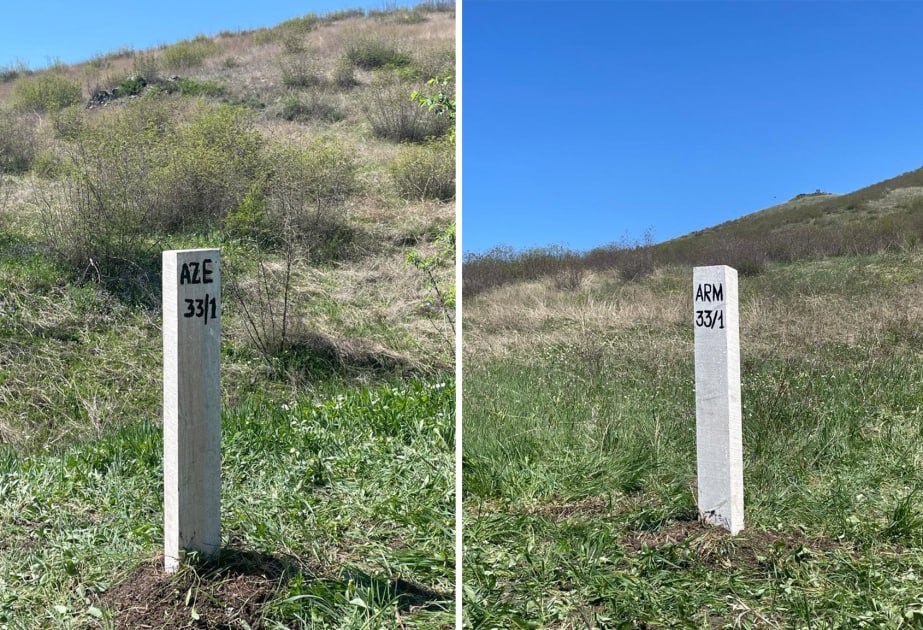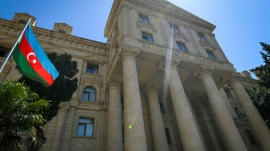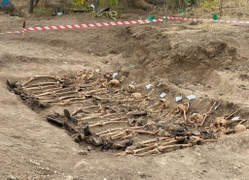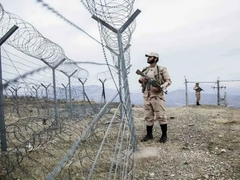Azerbaijan and Armenia started the process of demarcation of their border on Tuesday, with the installation of the first border markers based on geodetic measurements.
The relevant agreements came at the eighth meeting of the two countries’ state commissions for border delimitation, the press service of Azerbaijan’s Deputy Prime Minister Shahin Mustafayev reported.
Based on the results of the delimitation of the state border, expert groups from both countries have started refining coordinates based on ground geodetic measurements.
Last week, Armenia agreed to vacate four Azerbaijani border villages it has occupied since the early 1990s, when the two countries fought a bloody war in the Karabakh (Garabagh) region of Azerbaijan.
Shahin Mustafayev and his Armenian counterpart Mher Grigoryan reached the agreement on April 19 during a bilateral meeting at the border, according to statements from both governments.
Earlier this week, Armenian sappers commenced demining the border areas to handover the villages of Baganis Ayrim, Ashagi Askipara, Kheyrimli, and Gizilhajili to Azerbaijan.
The bilateral agreement, without foreign mediators, between Baku and Yerevan marks a significant step towards the peaceful resolution of border conundrum between the two countries.
The parties have agreed that they will base the delimitation process on the 1991 Alma-Ata Declaration. Signatories of the declaration, including Armenia and Azerbaijan, agreed to recognize and respect each other’s territorial integrity and the inviolability of the existing borders. The sides also agreed to continue the delimitation process on all other parts of the border, including enclave and exclave issues.
On Tuesday, President Ilham Aliyev of Azerbaijan said that a peace deal with Armenia was closer than ever before, as the two countries strive to delineate frontiers as a significant phase of the normalization process.
"We now have a common understanding of how the peace agreement should look like. We only need to address details," he said during a televised meeting with political analysts in Baku. "Both sides need time (...) We both have political will to do it," he added.
Last week, Armenia’s Prime Minister Nikol Pashinyan said the border delimitation was a "significant change" that would mean the two countries "now have a border and not a line of contact, which is a sign of peace."
A significant part of Azerbaijan’s state border with Armenia, measuring 1,007 kilometers, remained out of the country’s control for nearly 30 years after Karabakh (Garabagh) and East Zangezur regions fell under the illegal Armenian occupation in the early 1990s.
Following the Soviet Union’s dissolution in 1991, Armenia launched a full-blown military campaign against Azerbaijan, marking the longest and deadliest war in the South Caucasus region. The bloody war ended with a ceasefire in 1994, which saw Armenia forcibly occupying 20 percent of Azerbaijan’s internationally recognized territories. Over 30,000 Azerbaijanis were killed, and one million others were expelled from those lands in a brutal ethnic cleansing campaign conducted by Armenia.
On September 27, 2020, the decades-old conflict between the two countries took a violent turn after Armenian forces deployed in occupied Azerbaijani lands shelled military positions and civilian settlements of Azerbaijan. During the counter-attack operations, which lasted 44 days, Azerbaijani forces liberated over 300 settlements, including the cities of Jabrayil, Fuzuli, Zangilan, Gubadli and Shusha, from a nearly 30-year-long illegal Armenian occupation.
The war ended in a tripartite statement signed by Armenia, Azerbaijan, and Russia on November 10, 2020. Under the statement, Armenia also returned the occupied Aghdam, Kalbajar and Lachin districts to Azerbaijan.
The cartographic complications on the Armenia-Azerbaijan state border surfaced following Azerbaijan’s victory in the 2020 war, as a result of which the Azerbaijani army restored control over a large portion of the border with Armenia.







 The Azerbaijani government has rejected the recent claims made by French Interior Minister Gérard Darmanin, who accused Baku of fostering separatis...
The Azerbaijani government has rejected the recent claims made by French Interior Minister Gérard Darmanin, who accused Baku of fostering separatis...
 Iran is moving to fortify its eastern border with Afghanistan in a bid to fight illegal migration and drug trafficking, along with enhancing security.
Iran is moving to fortify its eastern border with Afghanistan in a bid to fight illegal migration and drug trafficking, along with enhancing security.
 The Iranian and Cuban transport ministers have discussed expanding maritime and air transportation cooperation.
The Iranian and Cuban transport ministers have discussed expanding maritime and air transportation cooperation.
 U.S. Secretary of State Antony Blinken reiterated Washington’s unwavering support for the ongoing peace process between Azerbaijan and Armenia in a...
U.S. Secretary of State Antony Blinken reiterated Washington’s unwavering support for the ongoing peace process between Azerbaijan and Armenia in a...



